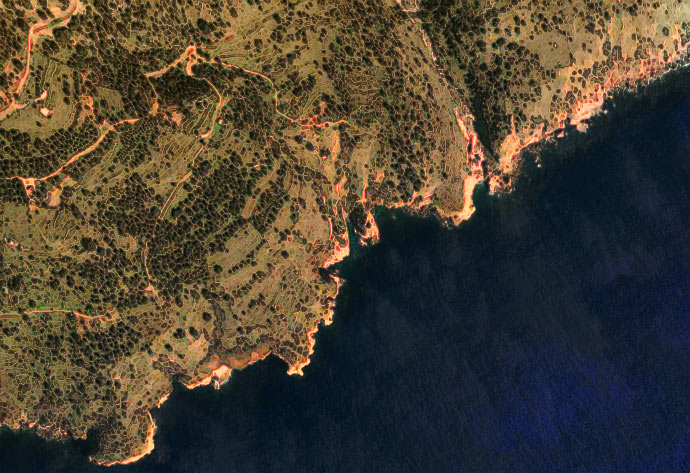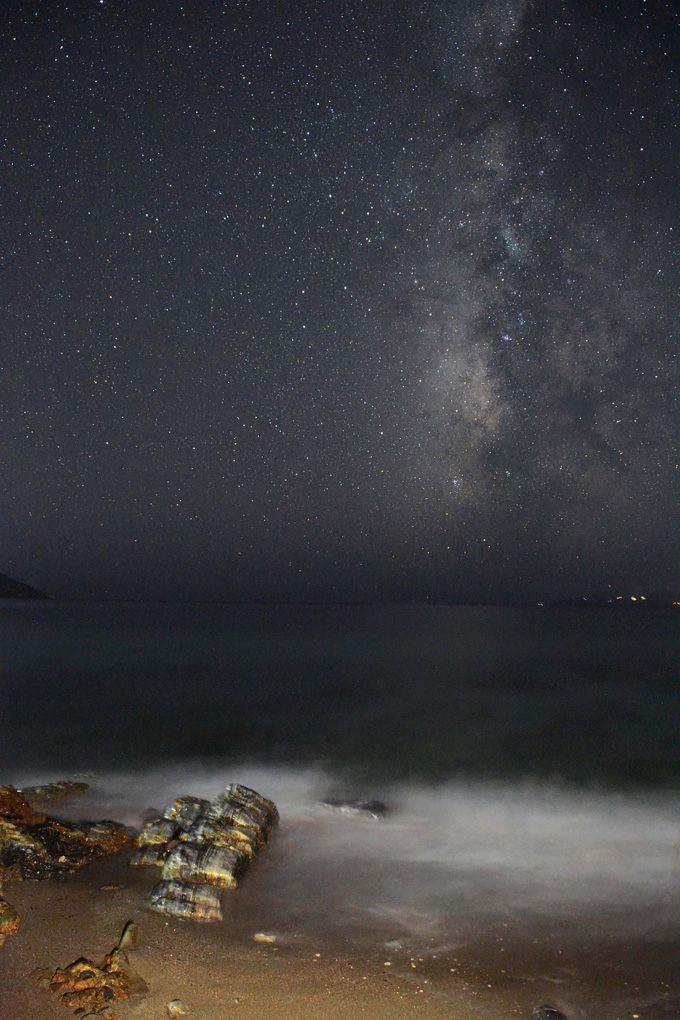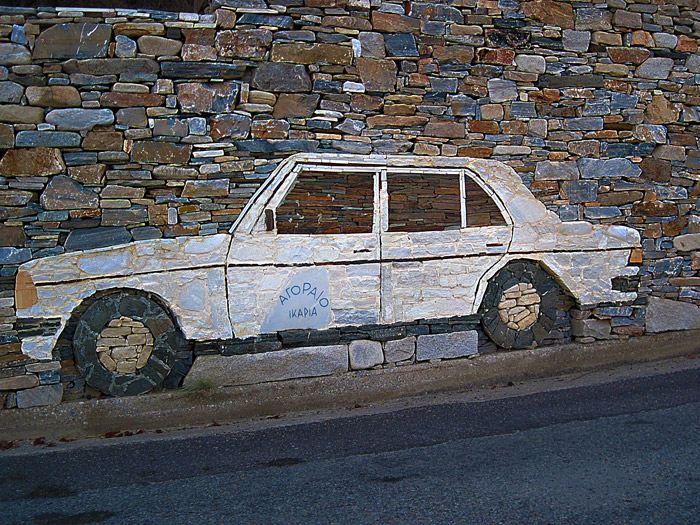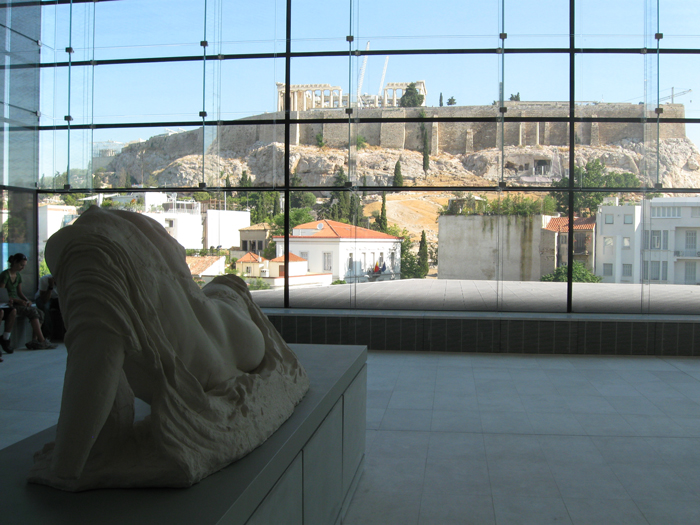Hole in the Clouds
Oct 19, 2009

Sail due north from the island of Crete, and you'll get to Athens. If Daedalus and his son Icarus had only had a boat, that is what they might have done. But King Minos was holding them prisoner in Crete--he was enraged because Daedalus had helped Theseus slay the Minotaur and run off with the princess. And King Minos controlled the waters all around Crete, so escape by sea was out of the question.
Daedalus, a native of Athens, had been banished from the city for murdering his apprentice/nephew, a twelve-year-old boy who was so clever that Daedalus was afraid of being overshadowed. He fled to Crete with his son, where he built the labyrinth that Minos eventually used to imprison the two of them. Of course having built the maze, Daedalus knew how to escape it. But escaping the island was a whole nother ball of wax.
He built wings for himself and Icarus from feathers and wax. They flew northeast, toward Troy. We all know what happened next: despite his father's warning, Icarus flew too high, too close to the hot sun, and the wax holding the wings to his arms melted in the heat. He fell to his death in the blue waters now bearing his name, the Ikarian Sea.
His body was retrieved from the sea by Hercules, and he was buried on a hillside overlooking the Ikarian Sea, on the Greek island now known as Ikaria.
This satellite image shows the Ikarian Sea and a hillside on Ikaria, a terraced olive grove. Not much in this scene has obviously changed in the thousands of years since Icarus got too uppity. Although the island is beautiful and the people there are known for their longevity, they have not prospered. Many of the children of Ikaria have fled to far corners of the globe, in a twentieth-century diaspora. They publish a newsletter to keep up with one another, and in the 1960s they held a reunion back home, on the island. There was no place to house all the returnees, so they rented a cruise ship to use as a hotel and parked it just offshore.
landscape
Greece
Crete
Icarus
Daedalus
(Image credit: Thanks to Tina Lackeos)
Jan 5, 2011
 Militarily speaking, the Greek War for Independence from the Ottoman Turks went pretty badly for the Greeks throughout the 1820s. Their first leader, the heroic Alexander Ypsilanti, died in battle almost immediately; his successors were provincial military strongmen who squabbled with one another and could not sustain focus on the overall goal. Even when Greek warriors succeeded in wresting a town or an island from the Turks, they often failed to hold onto it for long, as ships belonging to the Ottoman ally Egypt patrolled the sea and starved out the Greek "victors."
Militarily speaking, the Greek War for Independence from the Ottoman Turks went pretty badly for the Greeks throughout the 1820s. Their first leader, the heroic Alexander Ypsilanti, died in battle almost immediately; his successors were provincial military strongmen who squabbled with one another and could not sustain focus on the overall goal. Even when Greek warriors succeeded in wresting a town or an island from the Turks, they often failed to hold onto it for long, as ships belonging to the Ottoman ally Egypt patrolled the sea and starved out the Greek "victors."
But in the non-military propaganda war, which is what we see here in this 1826 painting by the Belgian-French artist Henri Decaisne, Greece performed magnificently. The philohellenism then fashionable in England, France, and Germany--the worship of all cultural things Greek--kept the war in the Western spotlight and provided the rebels with financial support, Romantic young volunteers, and ultimately military rescue and a Western-imposed peace settlement.
The British navy routed the Turks and Egyptians. Greek armies followed up on the naval victory with another round of attacks on the Turkish-held cities. Finally, in 1830, the crumbling Ottoman regime in Constantinople was forced to accept Western terms for Greek independence.
Decaisne called this painting, "Failed Military Operation."
Greece
exile
war
Lord Byron
Ottoman Empire
(Art by Henri Decaisne)
Dec 4, 2011

The stars of the Milky Way rise out of the Mediterranean in this time-release photo taken on the beach at the edge of the Greek village of Elia, near Molaoi. The earthly lights in the distance at far right are from the port of Gytheio, a few kilometers away. The brightest part of the Milky Way galaxy, in the right center of the picture near the constellation of Sagittarius, is about 27,000 light-years away.
beach
Greece
Elia
Molaoi
night sky
Gytheio
(Image credit: Stavros Hios)
Jan 11, 2013
 A taxi driver on the Greek island of Ikaria made himself a life-sized stone taxi on the wall outside his house.
A taxi driver on the Greek island of Ikaria made himself a life-sized stone taxi on the wall outside his house.
car
rocks
Greece
streetscape
signage
wall
taxi
stone
Ikaria
(Image credit: Tina Lackeos)
Apr 2, 2013
 The new Acropolis Museum in Athens frames a view of the real acropolis, which at the time of this photo in 2009 was undergoing the final stages of restoration, a thirty-five-year project aimed at undoing thousands of years of neglect and abuse.
The new Acropolis Museum in Athens frames a view of the real acropolis, which at the time of this photo in 2009 was undergoing the final stages of restoration, a thirty-five-year project aimed at undoing thousands of years of neglect and abuse.
Back in the seventeenth century, for example, the Parthenon Colonnades had been destroyed by Venetian bombardment and then reassembled incorrectly. Beginning in 1975, the colonnade was dismantled again, this time by experts who put the pieces back properly, using original stone, titanium screws, and a few slivers of new marble from Mount Penteli.
Greece
Athens
Acropolis
Parthenon
(h/t: Tina Lackeos)
Sep 18, 2013
 Our friend Tina Lackeos on the Greek island of Ikaria, gets together with a friend from her mother's village, woodcarver Panagiotis Safos.
Our friend Tina Lackeos on the Greek island of Ikaria, gets together with a friend from her mother's village, woodcarver Panagiotis Safos.
Greece
Ikaria
Tina
Panagiotis Safos
(Image credit: Martha Morgan)
Nov 10, 2014
 Self-portrait of the artist as three young girls, in Athens, Greece.
Self-portrait of the artist as three young girls, in Athens, Greece.
Greece
streetscape
photography
Athens
selfie
(Image credit: Ozyxy)
Feb 21, 2017
 With shopping bags, at the new town hall building in the Palaio Faliro district of Athens.
With shopping bags, at the new town hall building in the Palaio Faliro district of Athens.
cityscape
Greece
architecture
reflection
walking
Athens
glass
(Image credit: Dimitris Polydoropoulos)







